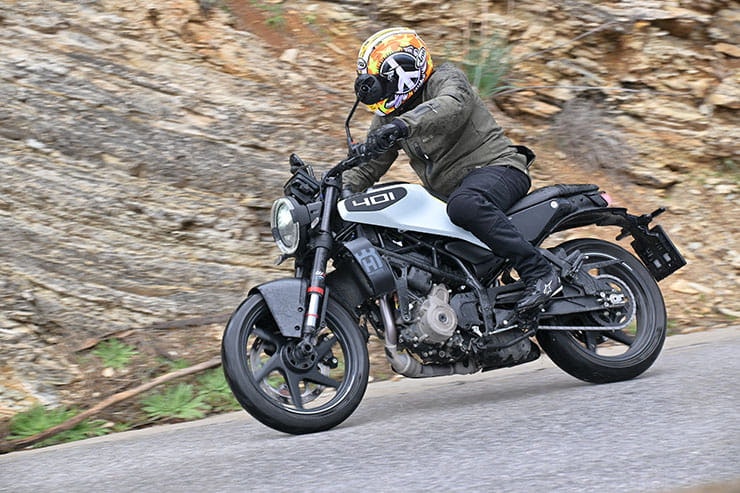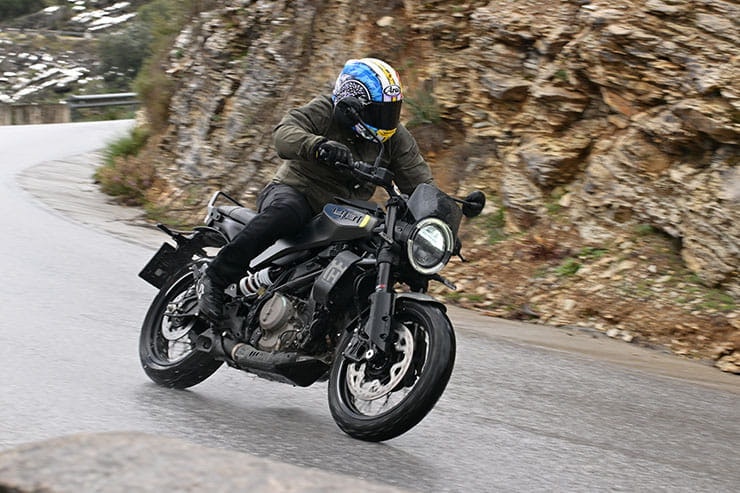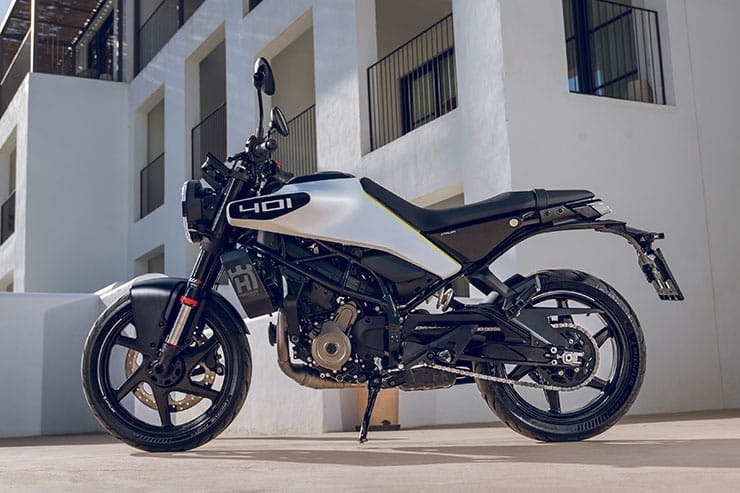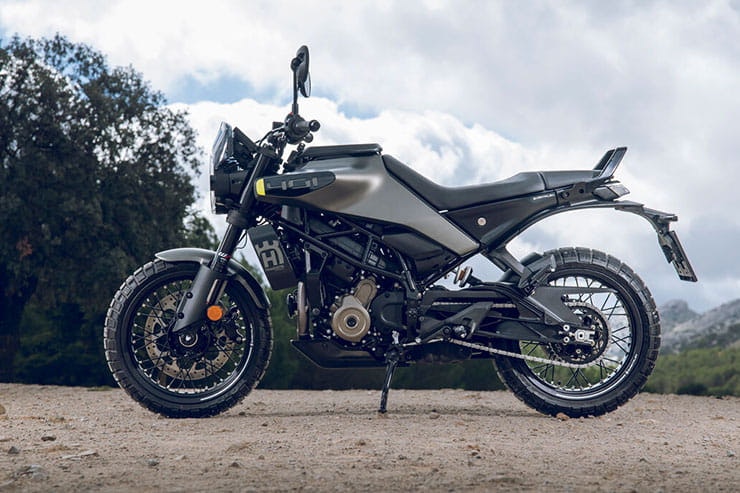Husqvarna Svartpilen 401 and Vitpilen 401 (2024) – Review
BikeSocial Road Tester
28.03.2024
Technical Review: Ben Purvis
Riding Review: Adam ‘Chad’ Child
Price: £5599 | Power: 45bhp | Weight: 159kg (Svartpilen), 154.5kg (Vitpilen) | Overall BikeSocial Rating: 4/5
When KTM whipped the covers off its completely new 2024-spec 390 Duke late last year the writing was on the wall for the closely-related Husqvarna Svartpilen and Vitpilen 401 models that share the Duke’s engine and chassis. Now the inevitable has happened and Husky has revealed its next-gen 401 models sharing the same technical improvements seen on the latest Duke.
But despite the shared components, the Husqvarnas manage to be quite distinct from the Duke in both style and stance, even if the distinction between the Svartpilen and Vitpilen is diminished for 2024, with the Vitpilen exchanging its café-racer riding position for a more upright, conventional posture like that of the scrambler-inspired Svartpilen version.
We zoomed to Spain to test ride both the new Svartpilen and Vitpilen in very English conditions.
New suspension including adjustable forks
Lower seat height to broaden appeal
New 5-inch TFT display
Cornering ABS and TC
Fuel tank is 4 litres larger to give greater range
Distinction between Svartpilen and Vitpilen is reduced
Visually indistinguishable from cheaper, slower 125cc versions
Michelin rubber on the Vitpilen not as impressive as Pirelli rubber on the Svartpilen
2024 Husqvarna Svartpilen 401 and Vitpilen 401 Review
Sharing a press launch and therefore a review, comes Husqvarna’s duo of 401 models, and we sent Chad to ride them both.
2024 Husqvarna Svartpilen 401 and Vitpilen 401 Price
Whether you opt for the street-biased Vitpilen 401, which swaps its wire wheels for cast alloys in 2024, or the scrambler-style Svartpilen 401 with wires, knobblier tyres, on-tank luggage rack and a small screen, the bill is the same: £5599.
That’s a pretty tempting deal, not least because it’s only £100 more than the previous-generation machines and £100 less than the KTM 390 Duke that shares its main mechanical bits with the new bikes. What’s more, compared to their predecessors, the Svartpilen and Vitpilen gain tech upgrades including a new TFT colour dash with phone connectivity for media, calls and navigation, as well as cornering ABS and traction control. Bargain. Dealers expect the bikes to start reaching them in February 2024.
A price of under £5600 will make both models competitive in this increasingly popular market. Based on styling, finish and specification, you would expect a higher price point, and yet both models are cheaper than the competition from Yamaha and Kawasaki. PCP deals for both models start at £119 per month which is only £20 a month more than their 125cc equivalents.
2024 Husqvarna Svartpilen 401 and Vitpilen 401 Engine & Performance
The KTM LC4c engine is the same unit used in the latest-generation, 2024 KTM 390 Duke, and despite its similarity to the previous 373cc LC4 single it’s actually a completely revamped design. The capacity rises to 399cc for 2024 thanks a 64mm stroke, 4mm more than before, coupled to the same 89mm bore used in the old model. But that understates the level of redesign needed to achieve the 26cc capacity hike. The LC4c is essentially a completely new engine compared to the LC4 that preceded it – the ‘c’ stands for ‘compact’ – and forms the basis of the latest KTM and Husqvarna street models from 125cc to 399cc.
The cases, covers, cylinder and head are new, as is the crankshaft, and the cylinder is lined with a plasma coating instead of Nicasil – a change that’s claimed to be cleaner and more sustainable, with fewer chemicals involved.
The new, four-valve, DOHC cylinder head is smaller, reducing weight and shifting the centre of gravity downwards, and inside it there are new camshafts to improve gas-flow. The fuel injection is new, too, with revised injectors inside a Dell ‘Orto throttle body for a finer mist, re-angled to fire onto the backs of the intake valves and reduce carbon build-up. The result meets the latest Euro5+ emissions limits.
Outside the engine, there’s a new airbox and a completely redesigned exhaust, while the six-speed transmission has been mildly revised. An ‘Easy Shift’ quick-shifter is standard, allowing clutchless changes once on the move.
The changes mean power rises a fraction, from a claimed 44hp in 2023 to 45hp in 2024, although it’s worth noting that number is partly chosen to make sure the new bikes meet the 0.2kW per kg power-to-weight ration demanded by the A2 licence class.
For 2024 the engine is tamed via a cornering traction control system, using an on-board lean angle sensor, although it can be switched off. There are also two riding modes – Street and Rain – to tailor the throttle response for different conditions.
Conditions for this test were not favourable, with near-zero temperatures and freezing rain doing their best to disrupt our ride. But at least the weather did allow us to flick between the Road and Rain modes and conduct a meaningful test. 'Rain' softens the fuelling and makes the throttle less responsive, but on a A2 bike that makes just 45bhp it’s not necessarily needed, even for inexperienced riders. In Road mode, tricky surfaces and low-speed, tippy-toe riding did highlight the sharpness of the throttle between closed and 20% open and, as expected from a single cylinder motor, a little lumpiness at low rpm compared to the twin cylinder bikes in this class. But it’s not bad. Unlike the KTM 390 on which these are heavily based, neither model has a track mode available.
Above 2,500rpm, the 399cc single smooths out and pulls keenly but it's in the zone between 4,000rpm and 8,000rpm where the LC4c truly excels. For an A2-compliant motor there is a surprising burst of acceleration, and enough drive to leave even the sportiest traffic in its wake. Keeps the rpm close to the 6000rpm sweet spot via the smooth-operating quick shifter, and the motor will deliver. There is even enough mid-range grunt to pop the front wheel up (with the traction control removed) if that’s your bag. Out of town, the 401 has more than enough power to stay with high-speed traffic, with 70mph to 80mph cruising easily achievable, if a little buzzy. Faster overtakes take a little planning, especially uphill, and while the magic 100mph is achievable, it takes a while to reach. On one section of closed road the dash showed an indicated 105mph... just.
My guess is that most Vitpilen and Svartpilen owners won't care too much about their machines' top-end performance, as both models are going spend the majority of their life in and around town and this is where the single feels happiest, dashing between lights, squirting ahead of the rat race on a lovely little burst of torque as you chase the horizontally-set rev counter across the dashboard.
Svartpilen’s ‘bars and rider view
2024 Husqvarna Svartpilen 401 and Vitpilen 401 Handling & Suspension (inc. Weight & Brakes)
Like the engine, the central section of the chassis used on both the Svartpilen and Vitpilen 401 is directly from the 2024 KTM 390 Duke, including the suspension components, but the Husqvarna models feature their own distinct tubular steel subframe instead of the KTM’s cast aluminium design.
The frame itself is still a steel trellis design, like its predecessor, but with a different layout and thickness of the tubing, which is hydroformed and robot-welded to ensure strength and consistency.
At the back, the rear shock has been offset to the right to make space for the new airbox and allow a lower seat height, and both the Vitpilen and Svartpilen share a longer wheelbase than before at 1357mm. The steering head angle has been steepened from 25 degrees to 24 degrees, for quicker response, and the overall torsional rigidity of the chassis is improved. At the back there’s a redesigned cast alloy swingarm, curved to clear the under-belly exhaust and to provide a mounting spot for the offset shock.
The suspension comes, as usual, from WP, with 43mm upside-down forks, but for 2024 they’re adjustable for compression and rebound damping via an adjuster on the top of each fork leg. An open cartridge design helps reduce weight and makes for easier maintenance than closed cartridge forks. The rear shock is adjustable for rebound damping and preload.
Like the 390 Duke they’re based on, the Svartpilen and Vitpilen each get a ByBre radial front brake caliper on a single 320mm disc, assisted by a 240mm rear one and two-piston caliper. They’re backed up by a Bosch cornering ABS system, which can be set to ‘Supermoto’ mode with the rear ABS disengaged, and both the brake and clutch lever are adjustable.
While the Svartpilen has wire wheels and a scrambler-style look, in contrast to the Vitpilen’s street-biased appearance, the two use essentially the same chassis components and dimensions. The biggest difference is really the wheels and tyres, with wires and Pirelli Scorpion Rally STR rubber on the Svartpilen in contrast to the cast alloys and Michelin Power 6 tyres on the Vitpilen.
Weight-wise, the Vitpilen comes in at a claimed 154.5kg, while the Svartpilen is a fraction heftier at 159kg.
Although the Husqvarnas share key components with the KTM 390 Duke, they're not simply KTMs in different colours; both have a different feel and character. And while the Vitpilen and Svartpilen are, on paper, very similar, again there is a distinction between the two on the road – especially in the wet.
Compared to the KTM, both feel more relaxed and refined and, thanks to a softer seat, slightly more accommodating. Without riding both manufacturers' bikes back-to-back, it’s hard to categorically say by how much, but there’s a noticeable difference. The Husqvarnas are slower steering – most bikes are – more predictable and more easy-going. The unsprung weight feels less on the KTM, the suspension a little firmer, while the smaller dimensions give it a lighter and sharper feel. KTM quote a wet weight of 165kg for the Duke, whereas the Vitpilen is 154.5 dry and the Svartpilen a little more at 159kg. Add fuel to the 401's 13-litre tank and it’s clear the KTM is the lighter bike – which is how it feels on the road.
Comparing the two Husqvarna’s is fundamentally down to tyre choice and one bike's slightly heavier feel. The street-styled Vitpilen comes on Michelin Power 6 rubber, which took ages to warm up and felt too hard when we tested the Duke recently. In the cold and wet of this test, it was a similar story as the tyres lacked feedback. The Pirelli shod Svartpilen, however, was much more up for the horrible weather. Instantly, I was more comfortable on the scrambler-styled machine; I had more feeling, which allowed me to ride with more confidence. The extra weight and marginally slower steering of the Svartpilen over the Vitpilen also helped.
In better weather conditions, with warmer and happier Michelins, I suspect I may prefer the slightly sportier Vitpilen, but with either bike you’ve got an excellent handling package, backed up by excellent rider aids. There's lean-sensitive ABS and traction control and Supermoto ABS, which allows you to lock the rear, and despite only having 45hp on tap, I could feel the TC system take over on many occasions. Young and inexperienced riders will certainly appreciate the extra security they bring to ride.
The Vitpilen’s ‘bars and clocks
2024 Husqvarna Svartpilen 401 and Vitpilen 401 Comfort & Economy
A change in ergonomics on the street-biased Vitpilen is the biggest departure for the whole range in 2024 – ditching its predecessor’s low-barred, forward-hunched, café-racer posture for something a bit more useable. The new bike has flat, wide, roadster-style bars mounted on risers above the forged aluminium top yoke, and while they’re lower than the off-road-style bars used on the Svartpilen, the difference is far less exaggerated than on the old model.
Other differences between the two include a one-piece seat on the Vitpilen and two-piece design for the Svartpilen, which also gets a pillion grab handle and a small, tinted flyscreen.
The new bodywork retains the distinctive look of the previous generation but when seen side-by-side with the old model the changes are substantial. There’s a new 13-litre fuel tank flanked by panels that now wrap forwards around the headstock and towards the front of the bike, and the seats manage to appear thicker and more padded than their predecessors while simultaneously dropping in height from 835mm to 820mm. As before, the Svartpilen gets a metal luggage platform on top of the tank, letting you attach magnetic tank bags.
New switch cubes promise improved ergonomics and operate that new, 5-inch TFT display, including phone functions.
There’s no word yet on fuel consumption, but the 13-litre tank with 1.5 litre reserve is substantially bigger than the small, 9.5-litre design used on the old models, so range is sure to be increased.
When it comes to running costs, the bikes are designed to be easy to service and have intervals of 10,000km (6000 miles) between oil and filter changes, after an initial 1000km (600 mile) check.
Our test ride route was over 200km, with riders swapping 401s at coffee and lunch stops. Comfort is impressive for this type of bike and certainly superior to the KTM 390 Duke. The 390 is much smaller, with a harder sportier seat. Both the 401s have wide interchangeable seats, just different in appearance which are comfortable, wide and plush. Unlike the KTM 390, there is even a decent perch for the pillion.
Due to the conditions, the ride was on the slow side and I averaged 3.9l/100km, which equates to 72mpg, highlighting what a fuel-efficient engine the LC4c can be. Ride harder, as I did on the KTM 390 last month, and that figure drops to 4.8l/100km or 59mpg, which is still impressive. The 401 has a larger fuel tank for 2024, up from 9.5l to 13l, giving a range of over 200 miles between fuel stops. Two hundred miles on a small A2 machine might sound painful – and would be the KTM 390 – but wouldn’t be so bad on either of the 401s and their plusher seats.
The Svartpilen comes with a small, tinted screen, which is more for show than actual wind protection, and there’s a grab handle as standard plus the luggage platform for the tank bag, which makes the Svart more suited for longer journeys. However, the Vitpilen isn’t as head-down radical as it once was and now has a more relaxed and upright riding position that's not too dissimilar from the Svartpilen's riding position. It's swings and roundabouts.
In detail (white bike is Vitpilen, dark for Svart’)
2024 Husqvarna Svartpilen 401 and Vitpilen 401 Equipment
The 5-inch TFT dash is a substantial upgrade on the old instrument panel, giving the bikes phone connectivity with control over media, calls and turn-by-turn navigation using the Ride Husqvarna app, all operated using the new bar control units. A USB-C port is standard to keep that phone charged.
Elsewhere, all the lighting is LED and the indicators have an auto-cancelling function to turn them off if you forget to do it. At the front, the oversized circular headlight includes a ring-shaped LED position light.
The dash on both 401s is neat, clear and bright, and although essentially the same as the KTM's in size and navigation, has a different look with a horizontal rev counter, which I like. I also like the way the dash flashes when you’re close to the limiter, and then fully illuminates when you hit it! The rider aids and modes are well displayed, too, though I do wonder if the dash might be a little too bright when it’s very dark and away from any light pollution. The new switchgear is the same as the KTM, so okay in terms of functionality but nothing to write home about.
Like the KTM, both bikes are made in India, which is why I assume they have managed to keep the price so competitive. The overall feel and quality are decent for a bike in this class and price point and, for me, the mature, bigger-bike looks of the 401 have it over the KTM 390.
2024 Husqvarna Svartpilen 401 and Vitpilen 401 Rivals
You’re spoilt for choice when it comes to single-cylinder bikes in the 400cc-ish region, with a vast array of models on the market. That’s where the distinctive style of the Husqvarna pair comes to the fore, offering something that stands out in a competitive field, and you’ll also struggle to find many others – apart from the mechanically-similar KTM 390 Duke – with rider aids like cornering traction control and lean-sensitive ABS.
Triumph Scrambler 400 X | Price: £5595
Power/Torque: 39.5bhp/26.7lb-ft | Weight: 179kg (including fuel)
KTM 390 Duke | Price: £5699
Power/Torque: 45bhp/28.8lb-ft | Weight: 165kg (including fuel)
Kawasaki Z500 | Price: £5699
Power/Torque: 44.8bhp/31.4lb-ft | Weight: 172kg (including fuel)
2024 Husqvarna Svartpilen 401 and Vitpilen 401 Verdict
The 401 shares many components and characteristics with the excellent and exciting KTM 390 Duke, which can only be beneficial. The 5-inch TFT dash is neat, the rider aids are top level for the A2-class, and the adjustable WP APEX suspension doesn’t feel low-budget like some bikes do in this sector. Overall, both 401s make for an impressive package.
But despite their strong family connection with the KTM, both the Vitpilen and Svartpilen feel more substantial and more comfortable than the 390, and some are likely to be drawn to the unusual but more sophisticated looks and larger feel of the Husqvarnas. However, I assume most younger riders will opt for the sportier, lighter orange number.
We really need to re-visit both bikes again for a dry test, but first impressions are very favourable. Svartpilen or Vitpilen? Both are priced the same, meaning a decision comes down to personal choice and style. I’d opt for the Pirelli shod Svartpilen, although I might remove the odd grab handle, which looks like it was stolen from an old Honda CBR600F.
If you’d like to chat about this article or anything else biking related, join us and thousands of other riders at the Bennetts BikeSocial Facebook page.
2024 Husqvarna Svartpilen 401 and Vitpilen 401 Technical Specification
Looking for motorcycle insurance? Get a quote for this motorbike with Bennetts bike insurance
What is MCIA Secured?
MCIA Secured gives bike buyers the chance to see just how much work a manufacturer has put into making their new investment as resistant to theft as possible.
As we all know, the more security you use, the less chance there is of your bike being stolen. In fact, based on research by Bennetts, using a disc lock makes your machine three times less likely to be stolen, while heavy duty kit can make it less likely to be stolen than a car. For reviews of the best security products, click here.
MCIA Secured gives motorcycles a rating out of five stars (three stars for bikes of 125cc or less), based on the following being fitted to a new bike as standard:
A steering lock that meets the UNECE 62 standard
An ignition immobiliser system
A vehicle marking system
An alarm system
A vehicle tracking system with subscription
The higher the star rating, the better the security, so always ask your dealer what rating your bike has and compare it to other machines on your shortlist.



